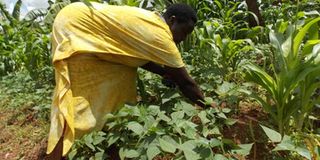Farmers advised on best practices to improve maize, bean production

A farmer attends to her garden of beans and maize. PHOTO BY MICHAEL J. SSALI
While Uganda is endowed with good soils and a favourable climate, agricultural production is far below potential and the produce often fails to meet quality standards.
Coffee, maize and beans are some of the food and cash crops produced but their marketability has proved to be an uphill task.
Against this backdrop, the Feed the Future initiative is conducting a series of trainings on how to increase production of the crops, to improve their quality and marketability, as well as to reduce malnutrition.
Better handling
Leaders of farmers’ groups, agro-inputs dealers, extension workers, local leaders and produce traders in Masaka sub-region early this month were engaged in a trainer-of-trainers workshop.
It covered how to improve bean and maize production and the benefits of good crop handling practices.
Lillian Bazaale, a Usaid consultant, told participants that some of the produce have been rejected due to failure to meet required market quality standards.
She emphasised that better handling from field to market helps farmers reduce waste and ensure the final product is of good quality.
To improve bean production, it is important to prepare the land well before planting, apply recommended fertilisers before and after planting, and follow advice by the extension officers such as the recommended spacing.
It is important to plant seed bought from a trusted agro-inputs dealer, and it should be the same variety.
Recommended practices
Participants were also advised to practice crop rotation and to avoid planting beans in the same garden every season. They should weed on time and endeavour to control pests and diseases.
Beans should be harvested when they are physiologically mature and during cool weather to avoid shattering.
The farmers were strongly advised to dry their harvest using mats or water-proof tarpaulins, and to keep domestic animals and birds such as chickens away from threshing, drying, and storage facilities to avoid contamination.
The farmer should winnow, sort and grade beans before storage and sale. The recommended moisture content for beans at storage should be 13 per cent and this can be measured with a moisture meter.
The device which is quite costly but as a group, the farmers can save money to purchase it and use in turns. The farmer should sort the beans by removing damaged and discoloured beans. The beans must be stored in a clean, dry, place and on pallets to avoid attracting moisture from the floor.
The storage area should be clean at all times and to control pests and vermin using recommended methods.
To increase maize production, farmers were advised to get improved seeds from a genuine dealer and to apply recommended practices—apply fertiliser properly, weed on time, fight pests and diseases, never harvest immature maize.
Like in the previous case of beans, harvested maize should be dried and shelled on clean tarpaulins, canvas or mats, with a provision to cover the crop in case of rain.
Good and hygienic crop handling at every stage enables farmers to get better prices and to reduce post-harvest losses.
Attain standards
“Traders want to get a reliable supply of high quality maize which they can easily sell to their clients,” Bazaale said.
“When the maize conforms to the standards and is available in large quantities, it is easier to sell to high value markets with less risk of the grain being rejected by the buyer. Processors want a continuous and reliable supply of quality raw materials. Consumers get food that is safe and nutritious to eat.”
Maize grain should be free of foreign objects such as bone fragments, bird excrement, and rat droppings.
It should not have stones, metal, sand, soil, grass, bits of maize cob or wood, and insects of any kind.
The harvested maize should not have any foul smell. It should be carefully sorted to remove broken grains, rotten and diseased grains as well as all grain damaged due to decay, moulding, insects, and vermin. Such grain normally has a different colour or carries clear weevil-bored holes and tunnels.
Bazaale emphasised the importance of farmers forming groups and selling their produce in bulk.




